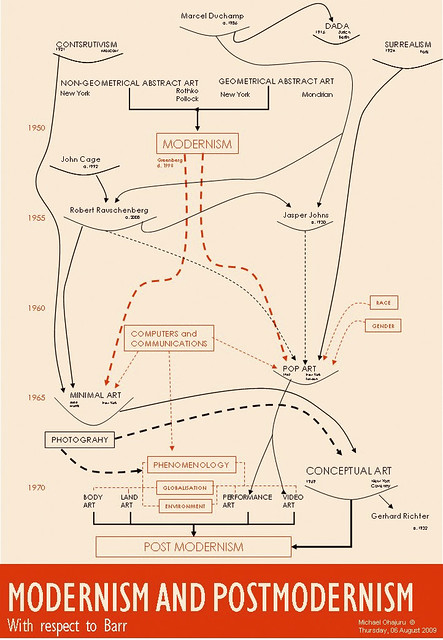Renaissance
Ut pictura poesis Horace 35BC
As is painting so is poetry.
Painting and poetry (and literature) are equal one was a source for the other, for inspiration and as an aid to interpretation. Look at Giotto’s Arena Chapel Fresco’s
Ars est Aretum celare Horace 35 BC
Art is to conceal art
All brush strokes are hidden , modelling is central – chiaroscuro effects are the aim.
Look at Leonardo’s Mona Lisa and try and find the brush strokes.
Romaniscim
L’art pour L’art Théophile Gautier (1811–1872)
Art for art sake
Art is free to ‘do its thing’ it had no moral or teaching purpose it was what it was, it needed no justification or origin. Try and explain Manet’s Le Dejeuner sur L’Herbe or rather why bother – just enjoy the view!
Modernism
Art est artum demonstrare Clement Greenberg 1940
Art is to reveal itself.#
The medium shows itself in the finished work aka medium specificity. Primary colours: no tones or tonality, dripping paint (if need be). Lines - clears and obvious the division between two colours. A move to flatness as that what a canvas is , who needs Renaissance’s perspective and verisimilitude ? See Pablo Picasso, 'Women of Algiers (O) (after Delacroix)' , its all there….the primary colours – straight out the tube; the black lines: separating the colours; the flat canvas – cubist effects to create the dept: unfinished look as though the artist was in a hurry (in fact on some Picasso’s you can still see the dripping paint marks
That's it...the history art - Renaissance : Romanticism : Modernism....Ut pictura poesis : Ars est Aretum celare : L’art pour L’art : Art est artum Demonstrare : QED
Ut pictura poesis Horace 35BC
As is painting so is poetry.
Painting and poetry (and literature) are equal one was a source for the other, for inspiration and as an aid to interpretation. Look at Giotto’s Arena Chapel Fresco’s
Ars est Aretum celare Horace 35 BC
Art is to conceal art
All brush strokes are hidden , modelling is central – chiaroscuro effects are the aim.
Look at Leonardo’s Mona Lisa and try and find the brush strokes.
Romaniscim
L’art pour L’art Théophile Gautier (1811–1872)
Art for art sake
Art is free to ‘do its thing’ it had no moral or teaching purpose it was what it was, it needed no justification or origin. Try and explain Manet’s Le Dejeuner sur L’Herbe or rather why bother – just enjoy the view!
Modernism
Art est artum demonstrare Clement Greenberg 1940
Art is to reveal itself.#
The medium shows itself in the finished work aka medium specificity. Primary colours: no tones or tonality, dripping paint (if need be). Lines - clears and obvious the division between two colours. A move to flatness as that what a canvas is , who needs Renaissance’s perspective and verisimilitude ? See Pablo Picasso, 'Women of Algiers (O) (after Delacroix)' , its all there….the primary colours – straight out the tube; the black lines: separating the colours; the flat canvas – cubist effects to create the dept: unfinished look as though the artist was in a hurry (in fact on some Picasso’s you can still see the dripping paint marks
That's it...the history art - Renaissance : Romanticism : Modernism....Ut pictura poesis : Ars est Aretum celare : L’art pour L’art : Art est artum Demonstrare : QED

No comments:
Post a Comment